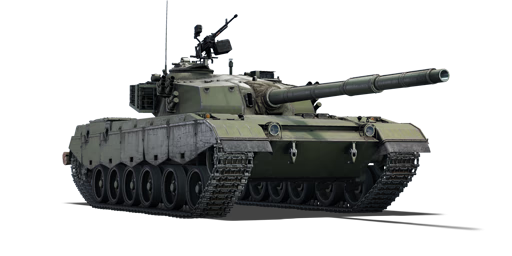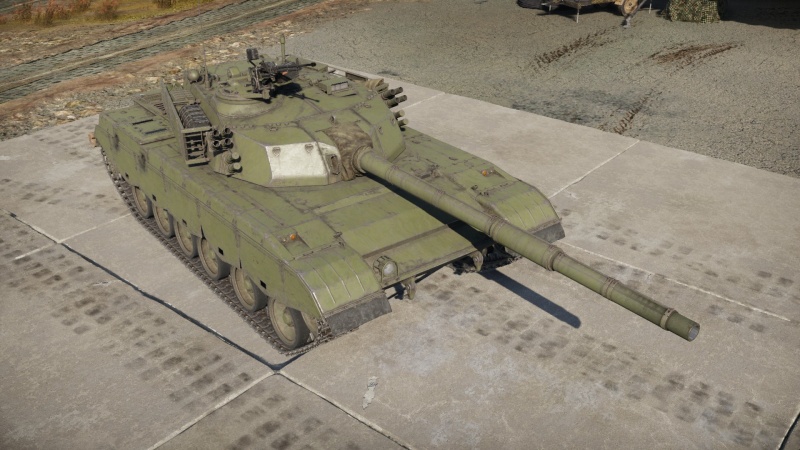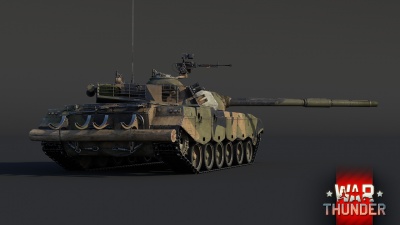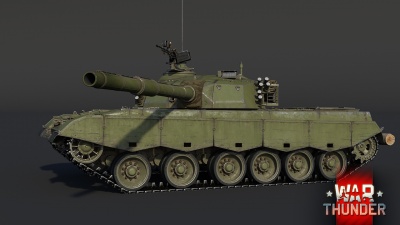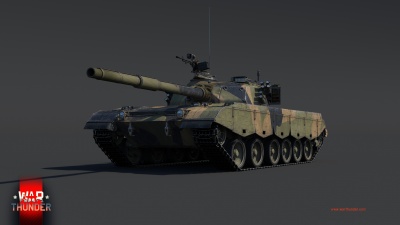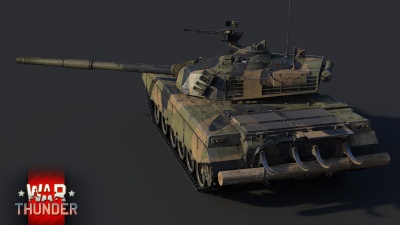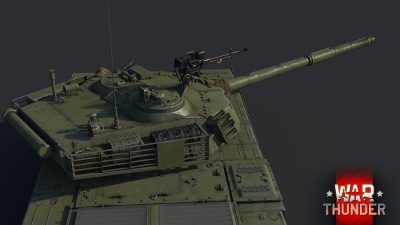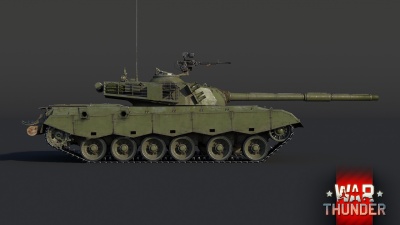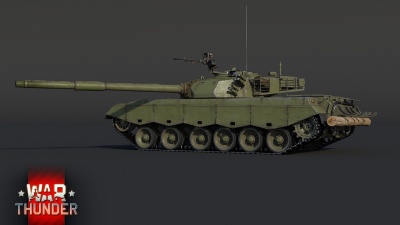Difference between revisions of "ZTZ96"
Colok76286 (talk | contribs) (Edits) |
(→Main armament: The battle rating of the ZTZ96 is now 9.3.) (Tag: Visual edit) |
||
| Line 45: | Line 45: | ||
{{main|Type 88C (125 mm)}} | {{main|Type 88C (125 mm)}} | ||
| − | The ZTZ96 makes up for its drawbacks in protection and mobility with a superb gun. The 125 mm Type 88C smoothbore gun is capable of firing APFSDS, HE and HEAT-FS ammunition. For its battle rating of 9. | + | The ZTZ96 makes up for its drawbacks in protection and mobility with a superb gun. The 125 mm Type 88C smoothbore gun is capable of firing APFSDS, HE and HEAT-FS ammunition. For its battle rating of 9.3, the 125-I shell performs very well, offering 466 mm of flat penetration at point-blank and dropping only to 434 mm at 2 kilometres. It's angled performance is exceptionally good at 269 mm at 60 degrees, outperforming even the best Soviet APFSDS round, 3BM42 whose angled penetration is only 248 mm. For reference, the 125-I performs comparably to Western long-rod sabot rounds such as DM33. The HEAT-FS round is nothing special with a standard 480 mm of penetration that is only really effective at destroying lightly armoured vehicles such as SPAA. The HE round is of the Soviet-style, packing a whopping 5.4 kg of TNT equivalent that can deal devastating damage against Western tanks' weak spots of the hull and turret roof and turret ring. It's recommended to entirely ditch the HEAT-FS for HE as it arguably performs better in the anti-tank role, ironically. |
Although the ZTZ96 uses a similar autoloader system to the T-72, its reload time of 7.5 seconds is slightly longer than the T-72's 7.1 seconds, which is already on the long side for its rank. | Although the ZTZ96 uses a similar autoloader system to the T-72, its reload time of 7.5 seconds is slightly longer than the T-72's 7.1 seconds, which is already on the long side for its rank. | ||
| Line 127: | Line 127: | ||
Notes: | Notes: | ||
| + | |||
* The 9th projectile rack and the 7th propellant rack are a mechanized first stage ammo rack. The mechanized nature indicates the tank has a fixed reload as it uses an autoloader to reload the main gun, as such the main gun cannot be reloaded when the ammo rack is empty. | * The 9th projectile rack and the 7th propellant rack are a mechanized first stage ammo rack. The mechanized nature indicates the tank has a fixed reload as it uses an autoloader to reload the main gun, as such the main gun cannot be reloaded when the ammo rack is empty. | ||
* It takes around 25s per shell to reload the first stage ammo rack. Additionally, there is a 10s interval between the gun is fully loaded and the crew starts to reload the first stage ammo rack. | * It takes around 25s per shell to reload the first stage ammo rack. Additionally, there is a 10s interval between the gun is fully loaded and the crew starts to reload the first stage ammo rack. | ||
Revision as of 08:31, 27 February 2021
Contents
Description
The ZhuangJia Tanke ZhuZhan 96 (sometimes referred to as Type 96) is a rank VI Chinese medium tank with a battle rating of 9.3 (AB/RB/SB). It was introduced in Update 1.93 "Shark Attack".
The first Chinese MBT in the game not directly based on or modified from a foreign design, the ZTZ96 has a more distinctive appearance and introduces several features not seen in previous Chinese medium tanks. The general layout is reminiscent of the Soviet T-72, but upon inspection, major differences are apparent in the design of the turret and hull. The welded turret is flat and angular compared to the dome shape traditionally favoured by the Soviet Union and China. The hull is a departure from the traditional T-54 chassis, featuring smaller roadwheels, different angles, and larger overall dimensions. Composite armour is present in the turret cheeks and on the upper glacis.
Like the T-72, the ZTZ96 features a 125 mm smoothbore cannon with an autoloader. Its shell selection is somewhat limited but the APFSDS and HE shells are excellent and can handle most ground targets. The protection and mobility are average at best, but those familiar with previous Chinese tanks will be used to these faults. ZTZ96 users can enjoy the great firepower and look forward to the succeeding ZTZ96A, a modernized and much-improved variant with thermal sights and ERA protection.
General info
Survivability and armour
The ZTZ96's armour is a significant improvement over previous Chinese tanks like the CM11 and ZTZ59D1 but is not very competitive for its rank. It has a significant amount of chemical protection in the turret cheeks (~520-530 mm) and upper glacis (~460-480 mm). The turret can resist most HEAT-FS rounds fired by enemy tanks but the hull might be penetrated on occasion by 120 mm HEAT-FS as used by the Leopard 2K and Leopard A1A1 (L/44) for example. Contemporary ATGMs will usually go right through.
Kinetic protection is decent but not spectacular, at about 390 mm for the turret cheeks and 360 mm for the hull depending on what round is used for testing. This is enough to stop early APFSDS rounds like the 105 mm DM23 fired by the Leopard A1A1, but many enemies at its rank can punch through it with their top rounds like 105 mm DM33/Type 93. Due to having a battle rating of 9.3, the ZTZ96 has some measure of isolation against top-tier guns. Contemporary US tanks like the MBT-70 or XM-1 (GM) will struggle to penetrate its composite armour and surprisingly even the British Challenger 1 series will have some difficulties. Overall, though the ZTZ96 has similarities to the T-72A, its armour protection is worse. The turret is weaker and the hull is comparable if the T-72's add-on armour upgrade is accounted for, slightly better otherwise.
As with other modern MBTs, the gun mantlet is highly susceptible to incoming fire, which can knock out the breech or hurt the crew. The lower glacis is also a weak point and should be hidden from enemy view when possible. However, due to the design of the upper glacis (which more closely resembles the T-54), there is no driver's viewport weak spot that plagues the contemporary T-64/72/80 tanks. This might surprise enemies with weaker rounds who shoot that area out of habit.
The post-penetration survivability leaves much to be desired. The autoloader uses the same layout as the T-72A; a penetrating shot to the lower glacis or hull side has a high likelihood of detonating the ammunition and instantly destroying the tank. Granted, this is slightly less likely to happen than in the T-64/80 since the propellant charges are stacked horizontally instead of vertically. In addition, with 3 only crew members, it is easier to knock out the tank with a good shot, particularly since the driver and gunner are lined up when the turret is facing forwards.
While hull penetrations tend to be fatal, this is not necessarily the case for turret penetrations. It is possible to empty the turret of spare ammunition by taking fewer rounds (22 + 1 for a full autoloader carousel and one in the gun). If an enemy shoots a turret cheek, usually only one crew member will perish, giving the player time to retreat if the gunner is lost or retaliate if only the commander is lost. The autoloader will ensure that the gun is loaded during this time.
Mobility
| Game Mode | Max Speed (km/h) | Weight (tons) | Engine power (horsepower) | Power-to-weight ratio (hp/ton) | |||
|---|---|---|---|---|---|---|---|
| Forward | Reverse | Stock | Upgraded | Stock | Upgraded | ||
| Arcade | 64 | 10 | 41 | 1,131 | 1,393 | 27.59 | 33.98 |
| Realistic | 58 | 9 | 646 | 730 | 15.76 | 17.8 | |
The mobility of the ZTZ96 is generally unimpressive, though still an improvement over preceding Chinese MBTs. It has 17.8 hp/ton when fully upgraded, which is about the same as the T-64B and less than the Challenger Mk.2; these two tanks are already considered quite immobile for their rank. The reverse speed of -7 km/h is painful but better than the agonizing 4 km/h of the Soviet T-64/72. Do not count on being able to retreat from danger rapidly. In general the ZTZ96 will be among the last to arrive on the battlefield in top rank battles, and one should plan accordingly. However, the tank is still quite manoeuvrable and agile in its hull traverse, allowing it to weave through dense forests and urban areas with relative ease and react quickly to threats.
Modifications and economy
Armaments
Main armament
The ZTZ96 makes up for its drawbacks in protection and mobility with a superb gun. The 125 mm Type 88C smoothbore gun is capable of firing APFSDS, HE and HEAT-FS ammunition. For its battle rating of 9.3, the 125-I shell performs very well, offering 466 mm of flat penetration at point-blank and dropping only to 434 mm at 2 kilometres. It's angled performance is exceptionally good at 269 mm at 60 degrees, outperforming even the best Soviet APFSDS round, 3BM42 whose angled penetration is only 248 mm. For reference, the 125-I performs comparably to Western long-rod sabot rounds such as DM33. The HEAT-FS round is nothing special with a standard 480 mm of penetration that is only really effective at destroying lightly armoured vehicles such as SPAA. The HE round is of the Soviet-style, packing a whopping 5.4 kg of TNT equivalent that can deal devastating damage against Western tanks' weak spots of the hull and turret roof and turret ring. It's recommended to entirely ditch the HEAT-FS for HE as it arguably performs better in the anti-tank role, ironically.
Although the ZTZ96 uses a similar autoloader system to the T-72, its reload time of 7.5 seconds is slightly longer than the T-72's 7.1 seconds, which is already on the long side for its rank.
| 125 mm Type 88C | Turret rotation speed (°/s) | Reloading rate (seconds) | |||||||||||
|---|---|---|---|---|---|---|---|---|---|---|---|---|---|
| Mode | Capacity | Vertical | Horizontal | Stabilizer | Stock | Upgraded | Full | Expert | Aced | Stock | Full | Expert | Aced |
| Arcade | 40 | -6°/+14° | ±180° | Two-plane | 28.6 | 39.5 | 48.0 | 53.1 | 56.5 | 7.50 | 7.50 | 7.50 | 7.50 |
| Realistic | 17.9 | 21.0 | 25.5 | 28.2 | 30.0 | ||||||||
Ammunition
| Penetration statistics | |||||||
|---|---|---|---|---|---|---|---|
| Ammunition | Type of warhead |
Penetration @ 0° Angle of Attack (mm) | |||||
| 10 m | 100 m | 500 m | 1,000 m | 1,500 m | 2,000 m | ||
| DTP-125 | HEATFS | 480 | 480 | 480 | 480 | 480 | 480 |
| DTB-125 | HE | 45 | 45 | 45 | 45 | 45 | 45 |
| 125-I | APFSDS | 466 | 464 | 458 | 450 | 442 | 434 |
| Shell details | |||||||||
|---|---|---|---|---|---|---|---|---|---|
| Ammunition | Type of warhead |
Velocity (m/s) |
Projectile Mass (kg) |
Fuse delay (m) |
Fuse sensitivity (mm) |
Explosive Mass (TNT equivalent) (g) |
Ricochet | ||
| 0% | 50% | 100% | |||||||
| DTP-125 | HEATFS | 905 | 18 | 0.05 | 0.1 | 2,190 | 65° | 72° | 77° |
| DTB-125 | HE | 850 | 23 | 0 | 0.1 | 5,460 | 79° | 80° | 81° |
| 125-I | APFSDS | 1,730 | 4.02 | N/A | N/A | N/A | 78° | 80° | 81° |
Ammo racks
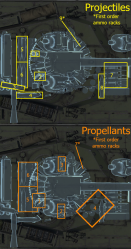
| Full ammo |
Ammo part |
1st rack empty |
2nd rack empty |
3rd rack empty |
4th rack empty |
5th rack empty |
6th rack empty |
7th rack empty |
8th rack empty |
9th rack empty |
Visual discrepancy |
|---|---|---|---|---|---|---|---|---|---|---|---|
| 40 | Projectiles Propellants |
40 (+0) 39 (+1) |
38 (+2) 38 (+2) |
37 (+3) 37 (+3) |
35 (+5) 31 (+9) |
32 (+8) 27 (+13) |
29 (+11) 23 (+17) |
24 (+16) 39 (+1) |
23 (+17) N/A |
39 (+1) N/A |
No |
Notes:
- The 9th projectile rack and the 7th propellant rack are a mechanized first stage ammo rack. The mechanized nature indicates the tank has a fixed reload as it uses an autoloader to reload the main gun, as such the main gun cannot be reloaded when the ammo rack is empty.
- It takes around 25s per shell to reload the first stage ammo rack. Additionally, there is a 10s interval between the gun is fully loaded and the crew starts to reload the first stage ammo rack.
Machine guns
| 12.7 mm QJC88A | ||||
|---|---|---|---|---|
| Mount | Capacity (Belt) | Fire rate | Vertical | Horizontal |
| Pintle | 500 (150) | 700 | -5°/+60° | ±180° |
| 7.62 mm Type 86 | ||||
|---|---|---|---|---|
| Mount | Capacity (Belt) | Fire rate | Vertical | Horizontal |
| Coaxial | 2,500 (250) | 700 | N/A | N/A |
Usage in battles
Like preceding Chinese MBTs, the ZTZ96 is not suited for rapid assaults due to its substandard mobility and should be played conservatively. Let speedier teammates charge first into combat while you cover them and move to good overwatch positions. Situational awareness is key since faster opponents may arrive earlier and the tank lacks thermal sights. The gun handling is a bit better than contemporary Soviet MBTs but it still has a slow vertical traverse speed.
Before the APFSDS is unlocked, the only options are the stock HEAT-FS and HE. Neither of these ammo types is particularly good for sniping due to their muzzle velocities, so it is best to stay at close to medium range. The HEAT-FS will struggle against enemies with decent composite armour (of which there are many) and in frontal engagements should be fired at weak spots like gun mantlets and turret rings. The HE has a slower muzzle velocity but can potentially be much deadlier; lightly armoured vehicles like IFVs, SPAAs, and certain MBTs (e.g. Leopard A1A1) will often hull-break or explode if hit anywhere. Even the most heavily armoured opponents like the mighty M1A2 Abrams and Leopard 2A5 can be instantly knocked out by hits to the gun optics or roof-mounted machine guns. If this isn't possible, hits to other sensitive areas like the turret ring and tracks can still cause major damage to various crew members and modules, priming the victim for a finishing blow.
Once the APFSDS is unlocked, it should be effective against the majority of the tanks seen at the ZTZ96's rank and is well suited for the ZTZ96's recommended laid-back playstyle. It is still a good idea to take some HE shells due to their utility and instant-knockout capability.
Assault mode
For players grinding the APFSDS in assault mode, it is recommended to bring full ammo, with around half HEAT and half HE. As the countdown goes at the start of the match, quickly find a spot where you will not get shot from every direction and stay there until you run out of ammo or die. The HEAT is great at one-shotting weakly armoured (relatively) cold war tanks that spawn at the early stages of the match, while the HE is capable of killing those heavily protected top tier MBT who spawn later. Given that you do not have APFSDS, therefore, lacking the ability to knock out some AI frontally, you will have to rely on assists to get scores. Firing HEAT / HE at tracks, roof-mounted MG, turret ring, cannon barrel, etc can at least immobile / disarm the AI, granting you an assist. The 7.5 second reload will be quite slow when facing a huge wave of AI so you must aim each shot carefully, but other times it is generally fast enough. The ZTZ96's armour can take quite some beating but is also prone to ammo rack explosion, or penetrating shots from the lower front plate and gun mantlet. Note that the ZTZ96 can be easily destroyed by rockets/bombs from AI planes too so it will be great to have a teammate with helicopter/SPAA covering the team.
Enemies worth noting:
- Leopard 2 A5: this is the most protected Leopard you will see in an assault, usually in Mozdok and Fulda. When facing it frontally or with slight angles, load HE and aim for its turret ring where the crosshair is green. It is very likely to destroy it instantly. When facing its side, load HEAT and aim for its central hull. Don't expect to block any of its shells as its APFSDS can easily go through the ZTZ96's frontal armour, or the AI can just target your weak spots.
- M1A2: you will see it mostly in Fulda and Ardennes. When facing it frontally or with slight angles, load HEAT and aim for its turret ring where the crosshair is green. It is very likely to destroy it instantly. HE might not work here since it cannot effectively hurt the turret crew. But HE works great when aiming at the M1's turret roof. Items like the MG and the optics will all detonate the HE, causing the downward shrapnel to kill all the crew. When facing its side, load HEAT and aim for its central hull.
- Challenger 2F: you will see it mostly in Sands of Sinai. It is one of the toughest AI to destroy, especially when there are waves of them. When facing it frontally or with slight angles, load HE and aim for the hull side above the tracks where the crosshair is green. It is very likely to detonate random ammo inside. When facing its side, still load HE and aim for its central hull for an ammo detonation. The Challenger 2F's sides are covered with ERA blocks thus HEAT will get absorbed.
- Type 16, Centauro ROMOR, Radkamfwagen 90: Despite being armed with 105 mm guns, these tanks get access to DM33 rounds that can penetrate your turret cheeks within 400m. In addition, their high speed means that it is incredibly easy to get flanked by them, frequently resulting in side-shots. This is only made worse by the weakened side armour of the ZTZ 96 compared to its soviet counterparts, resulting in light autocannon easily being able to penetrate the ZTZ 96's side armour from afar.
Pros and cons
Pros:
- Powerful gun with access to high-penetrating APFSDS
- Autoloader reloads the cannon even when putting out fires or replacing crew members
- HE shell is currently the most powerful of any MBT, can cripple or outright destroy enemies with a good shot
- Low profile
- First Chinese tank equipped with composite armour, resistant to early APFSDS rounds
- Roof mounted heavy machine gun is useful against aircraft and light targets
- Relatively-faster turret rotation speed, compared to contemporary Soviet tanks
Cons:
- Mobility is below average at its rank
- Composite armour's kinetic protection leaves some to be desired
- Sub-par armour compared to other tanks
- Autoloader carousel is a giant ammo rack
- No thermal sights, a disadvantage against other thermal-equipping tanks
- Poor reverse speed
- Below average gun depression (-6°)
- Only 3 crew members makes it easily destroyed
- No ATGM capability, unlike the T-64B and T-72B
History
The People's Liberation Army relied on the Type 59 as its primary main battle tank for most of the Cold War. While cheap, reliable, and quite upgradeable, its design began to shows its age over the decades. The Type 69 series differed little from the Type 59 in terms of appearance and was not used in quantity by the PLA. After relations with the Western world improved at the start of the 1980s, foreign technology was purchased and used to upgrade the PLA's stock of existing tanks. However, there was only so much that could be done to bring the Type 59 up to a competitive level and more efforts were devoted to domestic tank development.
The new Type 80/88 tank retained the general appearance of the Type 59, but its chassis was heavily redesigned, featuring a new suspension, a licensed German engine, and other changes. The turret retained the cast dome design but a 105mm gun was installed.
As with other PRC tank models, development continued for a long time and a large number of variants were made. The Type 85 branch featured welded turrets; the initial Type 85-1 "Storm" was intended for export and was otherwise similar to the original series, but no orders were placed from the PLA or export customers. A more radical development was the Type 85-IIM, which featured a welded turret equipped with an autoloading 125mm gun derived from the T-72. It also featured composite armour. This variant was exported to Pakistan under the designation of Type 85-IIAP.
The Type 85-IIM was later procured for domestic use, with some changes, as the Type 88C or Type 96, spurred by the poor performance of the Iraqi Army's Type 79 tanks (which featured comparable protection to the 80/88) in the Gulf War. As can be expected, this was further developed into the Type 96A and 96B variants. The 96A introduced applique "arrowhead" armour on the front turret face with provisions for ERA, improving protection significantly, and the electronics were improved to a standard approaching the top-line Type 99 tank, including a gunner's thermal sight and FCS upgrades. The 96A has participated in Tank Biathlons, where it scored well in gunnery but was let down by its underpowered engine. The ultimate 96B variant appeared in 2016 and features comprehensive all-round upgrades with a much more powerful 1130 hp engine. Finally, an export variant called the VT-2 has been showcased by Norinco, generally similar to the Type 96A.
At present the Type 96 series can be considered the backbone of the PLA's tank forces, featuring good protection and firepower with a relatively low weight and cost, comparable in role to the Russian T-90. Elite units are issued the more advanced and heavier Type 99, but cost and terrain reasons have limited its deployment. Outside of China, the Type 96 has been exported to Sudan; reportedly these tanks have destroyed several South Sudanese T-72s in combat.
Devblog
Work on the ZTZ96 began in the early 1990s, as new Chinese MBT with larger 125mm smoothbore cannon supported by an autoloading mechanism and new composite armour protection. The first prototype was built in May 1991 and underwent successful testing until January of the following year. Having received the official designation ZTZ85-IIAP, production of the vehicle commenced, with the Pakistani army receiving its first units shortly afterwards.
Several years later, the decision was made to adopt the ZTZ85-IIAP for domestic use as a stopgap measure to equip the PLA with a capable combat vehicle. In 1996, the vehicles destined for PLA use were formally redesignated into ZTZ96 and production of the type began in 1998.
Media
- Skins
- Images
- Videos
See also
- Vehicles equipped with the same chassis
External links
- [Development] ZTZ96: Top-Tier Chinese
- [Wikipedia] Type 96 tank
- [Tanks Encyclopedia] Norinco Type 96 MBT
| China medium tanks | |
|---|---|
| ZTZ59 | Type 59 · ZTZ59A · ZTZ59D1 |
| ZTZ69 | Type 69 · Type 69-IIa |
| ZTZ88/96 | ZTZ88A · ZTZ88B |
| ZTZ96 · ZTZ96A · ZTZ96A (P) | |
| ZTZ99 | ZTZ99-II · ZTZ99-III |
| ZTZ99A | ZTZ99A · WZ1001(E) LCT |
| Export series | MBT-2000 · VT4A1 |
| ROC | CM11 |
| Other | Т-34-85 Gai · Object 122MT "MC" |
| Bangladesh | T-69 II G |
| Japan | ␗Chi-Ha · ␗Chi-Ha Kai |
| Pakistan | Al-Khalid-I |
| USA | ␗M4A4 · ␗M4A4 (1st PTG) · ␗M4A1 (75) W · ␗M48A1 · ␗M60A3 TTS |
| USSR | ␗T-34 (1943) · ␗Т-34-85 (S-53) · T-34-85 No.215 · Т-62 №545 |


